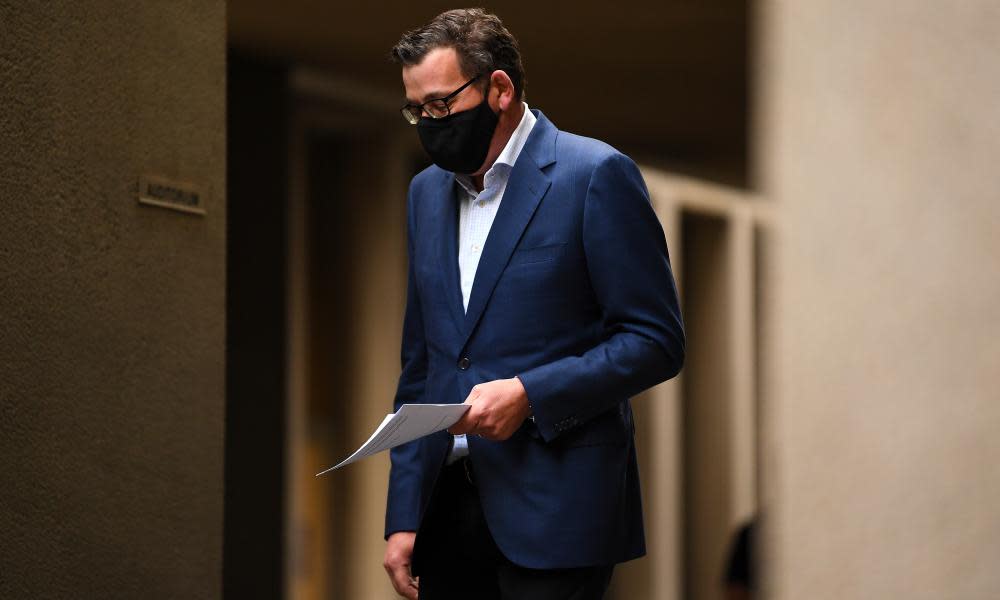Victoria may tighten regional restrictions after 'worrying' rise in Covid-19 cases traced to Melbourne

The number of coronavirus cases in regional Victoria has doubled in two weeks and the premier said there was “worrying trend” in the state’s three largest regional cities, some of which have seen a more than four-fold increase in active cases.
On Thursday Daniel Andrews announced three new testing sites and increased testing hours in Bendigo, Ballarat, and Geelong.
Genomic sequencing is yet to be conducted for the regional outbreaks, but contact tracers working for regional public health teams traced the initial outbreaks to Melbourne. All three regional cities are major commuter hubs, and travel for work is still permitted.
Concerningly, regional areas are seeing cases of untraced community transmission.
Greater Geelong has seen a four-fold increase in active cases since 29 July and as of Thursday had 143 active cases, up from 44 two weeks ago. But the trend is stabilising: most of that growth occurred in the first days of August, before Melbourne was placed under stage four restrictions and regional areas were returned to stage three.
Related: Regional Victoria stage 3 coronavirus restrictions and lockdown rules explained
The Victorian deputy chief health officer, Prof Allen Cheng, said the health department was looking “very closely” at whether Geelong might have to move to tighter restrictions.
“It’s a day-by-day proposition and we really encourage the community to come forward to get tested so that we can sort of get on top of these transmission chains and hopefully obviate the need for stage four,” Cheng said on Thursday.
“Noting that stage three has only been in for one week and we’re starting to see the impact of that now in regional centres, so it’s important we keep a close eye on these.”
Prof Eugene Athan, the director of infectious disease control at Barwon Health, which covers Geelong and surrounding areas, was “very confident” the number of new cases reported would slow considerably over the next fortnight as restrictions took effect.
Athan said most of the cases reported in the Barwon health district could be attributed to three outbreaks: the Australian Lamb Company at Colac, which grew to a cluster of more than 80 cases among workers and their close contacts; the Golden Farms Poultry chicken processing plant in Breakwater; Opal South Valley aged care home in Geelong, where most of the staff were stood down and the Australian Defence Force covered their shifts.
All three outbreaks were now contained, he said.
“So clearly some of this is linked to this very insecure workforce, where people might have two jobs,” Athan told Guardian Australia. “They might live in Werribee and work in an aged care home there and also work in another aged care home down in Geelong.”
In recent weeks the new cases have included “more isolated examples of community transmission”, but that was also decreasing.
Barwon was one of the first regional health districts to establish its own contact tracing team, now 60-strong. Athan said it was “much more agile than the centralised model”.
Active cases in Ballarat have more than doubled in the same period, and now sit at 22.
Greater Bendigo, which as of late July had just 11 active cases and 21 cases for the entire pandemic, now has 53 active cases and 73 in total – an almost five-fold increase in active cases in 14 days.
Bendigo Health’s chief executive, Peter Faulkner, said all but seven or eight of those cases had been connected by contact tracers to someone who either lived in, or had visited, metropolitan Melbourne.
“For most of these clusters we have been able to trace connections back in some way to the metropolitan area,” Faulkner said. “Some who have travelled from Melbourne, some who have visited family in Melbourne, or who live in Melbourne and work at places in Bendigo.”
The biggest cluster in the greater Bendigo region is 21 cases, linked to the Hazeldene’s Chicken Farm processing plant at Lockwood, followed by the cluster at Don KR Smallgoods in Castlemaine. There are also 20 cases linked to three schools, the largest of which is St Joseph’s primary school in Bendigo. Three aged care homes in the district have reported a single positive case among their staff.
“In each instance that has been the full extent of the outbreak,” Faulkner said.
Watch video below
For the past two weeks, Bendigo has been conducting contact tracing locally, with a team of 12 to 16. Close contacts are tested on the day they are identified, and also 11 days later, while they are still under orders to self-isolate, to see if the virus has developed. Faulkner said the local contact tracing model was preferable, because it “brings immediacy to the task”.
Smaller regional centres such as Shepparton have also reported an increase in cases. The greater Shepparton local government area has 16 active cases, compared with none two weeks ago. Most were reported in the past week.
To date, all of Shepparton’s new cases have been linked back to identified clusters.

 Yahoo News
Yahoo News 
